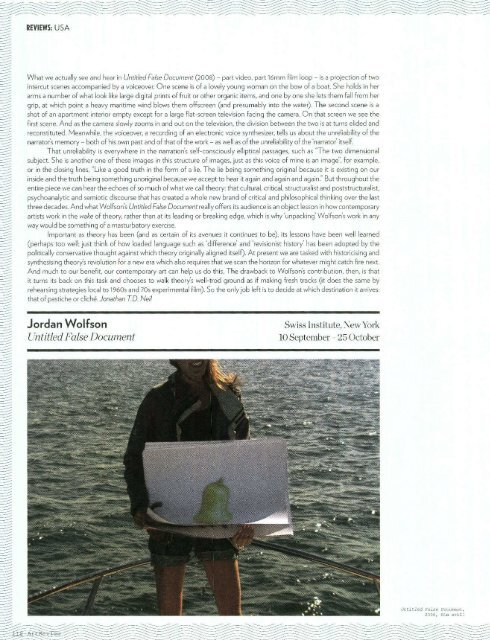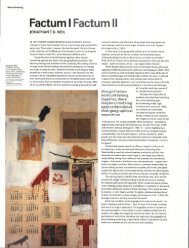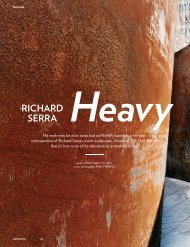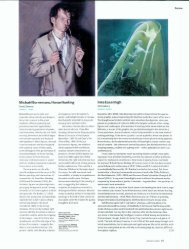âJordan Wolfson: Untitled False Document ... - Jonathan TD Neil
âJordan Wolfson: Untitled False Document ... - Jonathan TD Neil
âJordan Wolfson: Untitled False Document ... - Jonathan TD Neil
You also want an ePaper? Increase the reach of your titles
YUMPU automatically turns print PDFs into web optimized ePapers that Google loves.
REVIEWS: USA<br />
What we actually see and hear in <strong>Untitled</strong> <strong>False</strong> <strong>Document</strong> (2008) - part video, part 16mm film loop - is a projection of two<br />
intercut scenes accompanied by a voiceover. One scene is of a lovely young woman on the bow of a boat. She holds in her<br />
arms a number of what look like large digital prints of fruit or other organic items, and one by one she lets them fall from her<br />
grip, at which point a heavy maritime wind blows them offscreen (and presumably into the water). The second scene is a<br />
shot of an apartment interior empty except for a large flat-screen television facing the camera. On that screen we see the<br />
first scene. And as the camera slowly zooms in and out on the television, the division between the two is at turns elided and<br />
reconstituted. Meanwhile, the voiceover, a recording of an electronic voice synthesizer, tells us about the unreliability of the<br />
narrator's memory - both of his own past and of that of the work - as well as of the unreliability of the 'narrator' itself.<br />
That unreliability is everywhere in the narration's self-consciously elliptical passages, such as "The two dimensional<br />
subject. She is another one of these images in this structure of images, just as this voice of mine is an image", for example,<br />
or in the closing lines, "Like a good truth in the form of a lie. The lie being something original because it is existing on our<br />
inside and the truth being something unoriginal because we accept to hear it again and again and again." But throughout the<br />
entire piece we can hear the echoes of so much of what we call theory: that cultural, critical, structuralist and poststructuralist,<br />
psychoanalytic and semiotic discourse that has created a whole new brand of critical and philosophical thinking over the last<br />
three decades. And what <strong>Wolfson</strong>'s <strong>Untitled</strong> <strong>False</strong> <strong>Document</strong> really offers its audience is an object lesson in how contemporary<br />
artists work in the wake of theory, rather than at its leading or breaking edge, which is why 'unpacking' <strong>Wolfson</strong>'s work in any<br />
way would be something of a masturbatory exercise.<br />
Important as theory has been (and as certain of its avenues it continues to be), its lessons have been well learned<br />
(perhaps too well; just think of how loaded language such as 'difference' and 'revisionist history' has been adopted by the<br />
politically conservative thought against which theory originally aligned itself). At present we are tasked with historicising and<br />
synthesising theory's revolution for a new era which also requires that we scan the horizon for whatever might catch fire next.<br />
And much to our benefit, our contemporary art can help us do this. The drawback to <strong>Wolfson</strong>'s contribution, then, is that<br />
it turns its back on this task and chooses to walk theory's well-trod ground as if making fresh tracks (it does the same by<br />
rehearsing strategies local to 1960s and 70s experimental film). So the only job left is to decide at which destination it arrives:<br />
that of pastiche or clich6. <strong>Jonathan</strong> <strong>TD</strong>. <strong>Neil</strong><br />
Jordan W olfson<br />
Swiss Institute, NewYork<br />
<strong>Untitled</strong> <strong>False</strong> <strong>Document</strong> 10 September 25 October<br />
Uncitled <strong>False</strong> <strong>Document</strong>,<br />
2008, film still
COPYRIGHT INFORMATION<br />
TITLE: Jordan <strong>Wolfson</strong>: <strong>Untitled</strong> <strong>False</strong> <strong>Document</strong><br />
SOURCE: Art Rev no28 D 2008<br />
Copyright Art Review, Ltd. USA and Canadian subscription to Art<br />
Review are handled by agents: International Media Service, 3330<br />
Pacific Ave., Ste. 404, Virginia Beach, VA 23451, 800-428-3003.<br />
Annual subscription price $79, Canada $85. Our Internet address is<br />
http://www.art-review.co.uk





